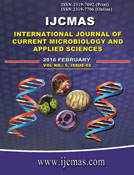


 National Academy of Agricultural Sciences (NAAS)
National Academy of Agricultural Sciences (NAAS)

|
PRINT ISSN : 2319-7692
Online ISSN : 2319-7706 Issues : 12 per year Publisher : Excellent Publishers Email : editorijcmas@gmail.com / submit@ijcmas.com Editor-in-chief: Dr.M.Prakash Index Copernicus ICV 2018: 95.39 NAAS RATING 2020: 5.38 |
There are various methods to synthesize AgNPs. Many methods are based on the reduction of Ag+ ions in a water solution. These methods use a reducing agent for the reduction of Ag+ ions in solution. A variety of chemical and physical procedures could be used for synthesis of metallic nanoparticles. However, these methods are fraught with many problems including use of toxic solvents, generation of hazardous by-products, and high energy consumption. Accordingly, there is an essential need to develop environmentally benign procedures for synthesis of metallic nanoparticles. A promising approach to achieve this objective is to exploit the array of biological resources in nature. Indeed, over the past several years, plants, algae, fungi, bacteria, and viruses have been used for production of low-cost, energy-efficient, and nontoxic metallic nanoparticles. In addition, the current interest in nanomaterials is focused on the controllable properties of size and shape because the optical, electronic, magnetic, and catalytic properties of metal nanoparticles strongly depend on their sizes and shapes. Controllability in biological methods is far easier to achieve than with other methods. Therefore, the use of microorganisms in the synthesis of nanoparticles emerges as an eco-friendly and exciting approach.
 |
 |
 |
 |
 |